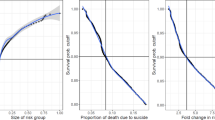Abstract
Background: Excessive mortality of suicide attempters has emerged from many follow-up studies. Completed suicide is the main cause of excess deaths, but the increased risk of deaths from other unnatural and natural causes is also of major public health concern. We lack follow-up studies of the different causes of death in cohorts of suicide attempters. The present study aimed to determine the mortality by suicide and other causes of death and to investigate risk factors. Methods: This mean 5.3-year follow-up study was based on an unselected cohort of suicide attempts by both violent and non-violent methods, treated in hospitals in a well-defined urban catchment area in Helsinki. In total, 2782 patients aged 15 years and over admitted to the emergency rooms after suicide attempt between 1989 and 1996 were included in the follow-up analysis. Standardised mortality ratios (SMR) for suicide, disease, accident, homicide, and undetermined death were calculated. Results: Mortality from all causes was 15 times higher than that expected among men and nine times higher in women. SMRs in men were 5402 (95% CI 4339–6412) for suicide, 2480 (95% CI 925–4835) for homicide, and 11,139 (95% CI 6884–16,680) for undetermined cause, and for women 7682 (95% CI 5423–9585), 3763 (95% CI 52–5880) and 15,681 (95% CI 6894-22,294), respectively. Fifteen percent of all suicide attempters died during the average 5.3-year follow-up of the index attempt. Deaths from suicide accounted for 37% of all excess deaths in men and 44% in women. The mortality ratio was highest during the 1st follow-up year. The total number of lost years of life among the 413 suicide attempters who died during follow-up was 13,883. The risk factors for all causes of death were male sex, single, retirement, drug overdose as a method, an index attempt not involving alcohol, and a repeated attempt. Conclusion: A suicide attempt indicates a severe risk of premature death, and suicide is the main cause of excess deaths. However, it appears that concentrating efficient treatment only on the most suicidal patients could prevent no more than two of five premature deaths. More effort is therefore needed to prevent the excess mortality of suicide attempters by also addressing causes of death other than suicide.
Similar content being viewed by others
Author information
Authors and Affiliations
Additional information
Accepted: 27 October 2000
Rights and permissions
About this article
Cite this article
Ostamo, A., Lönnqvist, J. Excess mortality of suicide attempters. Soc Psychiatry Psychiatr Epidemiol 36, 29–35 (2001). https://doi.org/10.1007/s001270050287
Issue Date:
DOI: https://doi.org/10.1007/s001270050287




